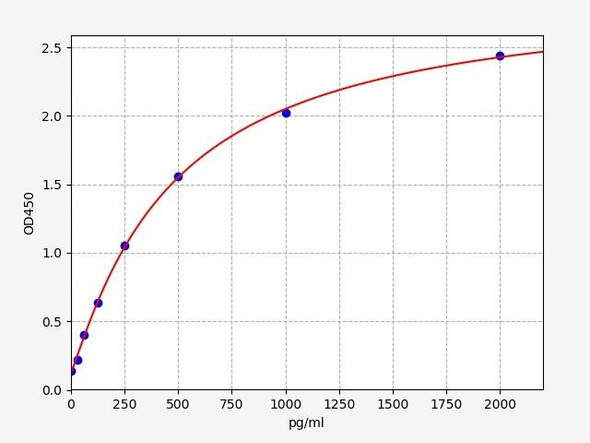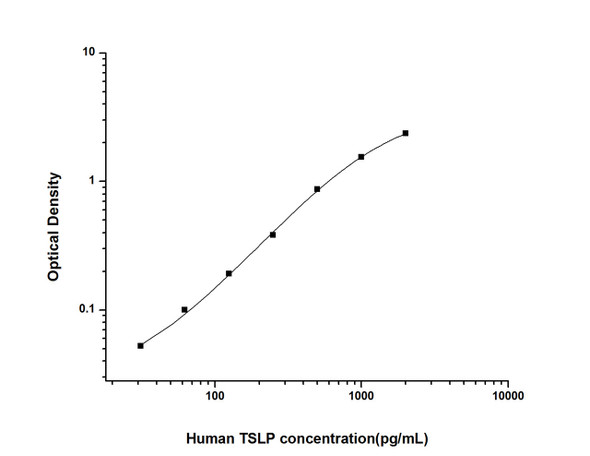Human Immunology ELISA Kits 1
Human TSLP (Thymic Stromal Lymphopoietin ) CLIA Kit (HUES00909)
- SKU:
- HUES00909
- Product Type:
- ELISA Kit
- ELISA Type:
- CLIA Kit
- Size:
- 96 Assays
- Sensitivity:
- 7.5pg/mL
- Range:
- 12.5-800pg/mL
- ELISA Type:
- Sandwich
- Synonyms:
- TSLP
- Reactivity:
- Human
- Sample Type:
- Serum, plasma and other biological fluids
- Research Area:
- Immunology
Description
| Assay type: | Sandwich |
| Format: | 96T |
| Assay time: | 4.5h |
| Reactivity: | Human |
| Detection method: | Chemiluminescence |
| Detection range: | 12.50-800 pg/mL |
| Sensitivity: | 7.50 pg/mL |
| Sample volume: | 100µL |
| Sample type: | Serum, plasma and other biological fluids |
| Repeatability: | CV < 15% |
| Specificity: | This kit recognizes Human TSLP in samples. No significant cross-reactivity or interference between Human TSLP and analogues was observed. |
This kit uses Sandwich-CLIA as the method. The micro CLIA plate provided in this kit has been pre-coated with an antibody specific to Human TSLP. Standards or samples are added to the appropriate micro CLIA plate wells and combined with the specific antibody. Then a biotinylated detection antibody specific for Human TSLP and Avidin-Horseradish Peroxidase (HRP) conjugate are added to each micro plate well successively and incubated. Free components are washed away. The substrate solution is added to each well. Only those wells that contain Human TSLP, biotinylated detection antibody and Avidin-HRP conjugate will appear fluorescence. The Relative light unit (RLU) value is measured spectrophotometrically by the Chemiluminescence immunoassay analyzer. The RLU value is positively associated with the concentration of Human TSLP. The concentration of Human TSLP in the samples can be calculated by comparing the RLU of the samples to the standard curve.
| UniProt Protein Function: | TSLP: Cytokine that induces the release of T-cell-attracting chemokines from monocytes and, in particular, enhances the maturation of CD11c(+) dendritic cells. Can induce allergic inflammation by directly activating mast cells. |
| UniProt Protein Details: | Protein type:Secreted; Secreted, signal peptide Chromosomal Location of Human Ortholog: 5q22. 1 Cellular Component: extracellular space Molecular Function:cytokine activity |
| NCBI Summary: | This gene encodes a hemopoietic cytokine proposed to signal through a heterodimeric receptor complex composed of the thymic stromal lymphopoietin receptor and the IL-7R alpha chain. It mainly impacts myeloid cells and induces the release of T cell-attracting chemokines from monocytes and enhances the maturation of CD11c(+) dendritic cells. The protein promotes T helper type 2 (TH2) cell responses that are associated with immunity in various inflammatory diseases, including asthma, allergic inflammation and chronic obstructive pulmonary disease. The protein is therefore considered a potential therapeutic target for the treatment of such diseases. Alternative splicing of this gene results in multiple transcript variants. [provided by RefSeq, Jan 2012] |
| UniProt Code: | Q969D9 |
| NCBI GenInfo Identifier: | 74751719 |
| NCBI Gene ID: | 85480 |
| NCBI Accession: | Q969D9. 1 |
| UniProt Secondary Accession: | Q969D9,Q8IW99, Q96AU7, G3XAM8, |
| UniProt Related Accession: | Q969D9 |
| Molecular Weight: | 7,426 Da |
| NCBI Full Name: | Thymic stromal lymphopoietin |
| NCBI Synonym Full Names: | thymic stromal lymphopoietin |
| NCBI Official Symbol: | TSLP |
| NCBI Protein Information: | thymic stromal lymphopoietin |
| UniProt Protein Name: | Thymic stromal lymphopoietin |
| Protein Family: | Thymic stromal lymphopoietin |
| UniProt Gene Name: | TSLP |
| UniProt Entry Name: | TSLP_HUMAN |
As the RLU values of the standard curve may vary according to the conditions of the actual assay performance (e. g. operator, pipetting technique, washing technique or temperature effects), the operator should establish a standard curve for each test. Typical standard curve and data is provided below for reference only.
| Concentration (pg/mL) | RLU | Average | Corrected |
| 800 | 48146 57138 | 52642 | 52616 |
| 400 | 19695 23773 | 21734 | 21708 |
| 200 | 9880 9536 | 9708 | 9682 |
| 100 | 4312 4792 | 4552 | 4526 |
| 50 | 2345 2031 | 2188 | 2162 |
| 25 | 1088 1032 | 1060 | 1034 |
| 12.50 | 479 539 | 509 | 483 |
| 0 | 25 27 | 26 | -- |
Precision
Intra-assay Precision (Precision within an assay): 3 samples with low, mid range and high level Human TSLP were tested 20 times on one plate, respectively.
Inter-assay Precision (Precision between assays): 3 samples with low, mid range and high level Human TSLP were tested on 3 different plates, 20 replicates in each plate.
| Intra-assay Precision | Inter-assay Precision | |||||
| Sample | 1 | 2 | 3 | 1 | 2 | 3 |
| n | 20 | 20 | 20 | 20 | 20 | 20 |
| Mean (pg/mL) | 36.53 | 106.91 | 390.11 | 36.20 | 108.80 | 363.57 |
| Standard deviation | 3.34 | 10.48 | 38.04 | 3.17 | 8.54 | 39.88 |
| C V (%) | 9.14 | 9.80 | 9.75 | 8.76 | 7.85 | 10.97 |
Recovery
The recovery of Human TSLP spiked at three different levels in samples throughout the range of the assay was evaluated in various matrices.
| Sample Type | Range (%) | Average Recovery (%) |
| Serum (n=5) | 94-110 | 102 |
| EDTA plasma (n=5) | 90-104 | 97 |
| Cell culture media (n=5) | 89-103 | 94 |
Linearity
Samples were spiked with high concentrations of Human TSLP and diluted with Reference Standard & Sample Diluent to produce samples with values within the range of the assay.
| Serum (n=5) | EDTA plasma (n=5) | Cell culture media (n=5) | ||
| 1:2 | Range (%) | 91-105 | 89-101 | 86-101 |
| Average (%) | 98 | 94 | 93 | |
| 1:4 | Range (%) | 95-112 | 92-104 | 93-108 |
| Average (%) | 102 | 97 | 99 | |
| 1:8 | Range (%) | 85-98 | 99-111 | 89-100 |
| Average (%) | 92 | 104 | 95 | |
| 1:16 | Range (%) | 88-102 | 101-115 | 89-101 |
| Average (%) | 95 | 108 | 94 |
An unopened kit can be stored at 4°C for 1 month. If the kit is not used within 1 month, store the items separately according to the following conditions once the kit is received.
| Item | Specifications | Storage |
| Micro CLIA Plate(Dismountable) | 8 wells ×12 strips | -20°C, 6 months |
| Reference Standard | 2 vials | |
| Concentrated Biotinylated Detection Ab (100×) | 1 vial, 120 µL | |
| Concentrated HRP Conjugate (100×) | 1 vial, 120 µL | -20°C(shading light), 6 months |
| Reference Standard & Sample Diluent | 1 vial, 20 mL | 4°C, 6 months |
| Biotinylated Detection Ab Diluent | 1 vial, 14 mL | |
| HRP Conjugate Diluent | 1 vial, 14 mL | |
| Concentrated Wash Buffer (25×) | 1 vial, 30 mL | |
| Substrate Reagent A | 1 vial, 5 mL | 4°C (shading light) |
| Substrate Reagent B | 1 vial, 5 mL | 4°C (shading light) |
| Plate Sealer | 5 pieces | |
| Product Description | 1 copy | |
| Certificate of Analysis | 1 copy |
- Set standard, test sample and control (zero) wells on the pre-coated plate and record theirpositions. It is recommended to measure each standard and sample in duplicate. Note: addall solutions to the bottom of the plate wells while avoiding contact with the well walls. Ensuresolutions do not foam when adding to the wells.
- Aliquot 100 µL of standard solutions into the standard wells.
- Add 100 µL of Sample / Standard dilution buffer into the control (zero) well.
- Add 100 µL of properly diluted sample (serum, plasma, tissue homogenates and otherbiological fluids. ) into test sample wells.
- Cover the plate with the sealer provided in the kit and incubate for 90 min at 37 °C.
- Aspirate the liquid from each well, do not wash. Immediately add 100 µL of BiotinylatedDetection Ab working solution to each well. Cover the plate with a plate seal and gently mix. Incubate for 1 hour at 37 °C.
- Aspirate or decant the solution from the plate and add 350 µL of wash buffer to each welland incubate for 1-2 minutes at room temperature. Aspirate the solution from each well andclap the plate on absorbent filter paper to dry. Repeat this process 3 times. Note: a microplatewasher can be used in this step and other wash steps.
- Add 100 µL of HRP Conjugate working solution to each well. Cover with a plate seal andincubate for 30 min at 37 °C.
- Aspirate or decant the solution from each well. Repeat the wash process for five times asconducted in step 7.
- Add 100 µL of Substrate mixture solution to each well. Cover with a new plate seal andincubate for no more than 5 min at 37 °C. Protect the plate from light.
- Determine the RLU value of each well immediately.






